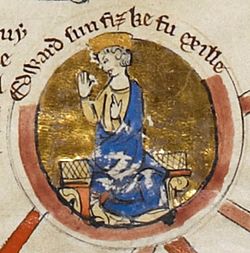Edward the Exile facts for kids
Quick facts for kids Edward the Exile |
|
|---|---|

Edward the Exile depicted on a medieval genealogical scroll.
|
|
| Born | 1016 |
| Died | 19 April 1057 (aged 40–41) England |
| Spouse | Agatha |
| Issue | |
| House | Wessex |
| Father | Edmund Ironside |
| Mother | Ealdgyth |
Edward the Exile (born 1016 – died 19 April 1057) was an English prince. He was also known as Edward Ætheling. His father was King Edmund II of England, also called Edmund Ironside. His mother was Ealdgyth. Edward spent most of his life far from England, in a country called the Kingdom of Hungary. This happened after his father lost a big battle to Cnut the Great.
Life in Exile
After the Danes took over England in 1016, King Canute sent Edward and his brother Edmund away. Edward was only a few months old at the time. Canute sent them to the Swedish court of Olof Skötkonung. Some people say Canute wanted the children to be killed. However, Olof was a friend of Edward's grandfather, Æthelred the Unready. So, Olof refused to harm the young princes.
What happened next is a bit of a mystery. Some historians believe Olof sent them to the Hungarian royal court of King Stephen I. Others think they went to the Kievan court, which is now part of Ukraine. They might have gone there after Canute took over Norway and Sweden in 1028.
It is thought that Edward and Edmund met another prince in exile, Andrew of Hungary, in the 1030s. Prince Andrew went back to Hungary in 1046 to become king. Edward and Edmund likely went with him and fought in his army. They might even have been at his coronation. There's a place in Hungary called "Terra Britanorum de Nadasd" (Land of the Britons of Nadasd). Local stories say King Stephen gave this land to Edward. If this is true, it means Edward was in Hungary before 1038.
Return to England
In 1056, Edward the Confessor, who was the King of England, heard that Edward the Exile was still alive. The King decided to call him back to England and make him his heir. This was a very important moment. Edward the Exile was the last hope for the Saxon royal family to have a clear and accepted person to take the throne.
At this time, the old Anglo-Saxon monarchy was facing problems. King Edward the Confessor was a good person but not a strong ruler. He had no children. Powerful families, like the sons of Godwin, Earl of Wessex, were becoming very strong. Also, William, Duke of Normandy, from across the English Channel, was also interested in becoming the next king.
Edward the Exile seemed to arrive at just the right time. Both the King and the Witan (a council of important people) approved of him. He offered a way to stop the powerful Godwinsons and William. His claim to the throne was very strong and hard to argue against.
In 1054, King Edward sent Ealdred, the Bishop of Worcester, to talk with the German emperor. The goal was to arrange for Edward the Exile to return from Hungary. At first, Ealdred was not successful. In 1056, Earl Harold Godwinson traveled to Flanders, and possibly Germany and Hungary. This trip was probably to help with the negotiations.
Edward the Exile finally arrived in England in 1057 with his wife and children. Sadly, he died just a few days later, on April 19. He never even got to meet the King. He was buried in Old St Paul's Cathedral.
Family Life
Edward's wife was named Agatha. People are not sure where she came from. They had three children:
- Edgar Ætheling (born around 1051 – died around 1126) – He was chosen as King of England after the Battle of Hastings. But he later gave up his claim to William the Conqueror.
- Saint Margaret of Scotland (born around 1045 – died 16 November 1093) – She married King Malcolm III of Scotland.
- Cristina (born around 1040 – died around 1093) – She became an abbess at Romsey Abbey.
Edward's granddaughter, Edith of Scotland (also called Matilda), married King Henry I of England. This meant that the Anglo-Saxon royal line continued even after the Norman Conquest through the English monarchy.
See also
 In Spanish: Eduardo el Exiliado para niños
In Spanish: Eduardo el Exiliado para niños 

